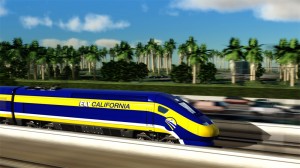California’s high speed rail system is currently in the hands of the state court system. An adverse decision could kill the opportunity to get federal funding and therefore likely kill the project for a generation. But in the meantime, plans proceed to start the line in the San Joaquin Valley, an area largely hostile to high speed rail due to conservative politics and lacking in a solid population or political base to advocate for the system’s expansion to the coasts.
So where should high speed rail start? Los Angeles to San Diego. The two cities are major population centers that are too close to fly and too far for a convenient drive (it’s taken me four hours due to traffic). It’s basically the perfect situation for high speed rail, and the Amtrak line serving the two cities is already successful. An electrification and upgrade to the speed would make this ride profitable enough that operating revenue could cover costs.
Building the system in this urban area will be expensive and challenging. And the federal government already requires construction to begin in the Valley for purely political reasons to qualify for federal funds (I hear there are engineering advantages to “test” the trains on the flat Valley surface, but that makes no sense to me for a proven technology like high speed rail). Meanwhile, the state doesn’t even have a plan to extend the system to San Diego until the 2030s and probably later.
Given the situation, high speed rail advocates should push for a three-county bond issue to build this segment of the track (in Los Angeles, Orange, and San Diego Counties). Once built, the system pays for itself and provides millions of residents with access to high speed rail each year. And then with that constituency in favor, the system could be expanded north to Bakersfield, Sacramento, and San Francisco.
This localized high speed rail approach should happen even if the courts save high speed rail. Southern Californians shouldn’t have to wait a generation for service, and the state shouldn’t have to pay for less-than-optimal corridors to receive high speed rail first.
Okay high speed rail advocates in Southern California. Time to start planning for November 2016. You heard it hear first (I think).
3 thoughts on “Where California Should Start High Speed Rail”
Comments are closed.




Discussion of the California high speed rail (HSR) project should first address why Madera-to-Fresno is an unacceptably unproductive initial operating segment. The LA-to-SD segment can be favored instead, but isn’t far enough along in the planning process to give affected communities any sense of impact, property takings, grade separations, station siting etc – nevermind objectionable cost estimates.
I’ve always been an advocate for a Talgo XXI trainset system that only reaches 135mph but minimizes impact and cuts cost nearly in half. The Talgo XXI is a hybrid locomotive that can run all-electric through dense urban areas and tunnels, run diesel/electric through rural areas (Merced-to-Bakersfield) where the environmental benefit of electrification is moot and an unecessary as well as unproductive expense. A Talgo XXI trip time LA-to-SF is 5 hours, 4.5 hours to Sacramento; not bad considering Coast Starlighter trip time is 11-12 hours. Tilting Talgo technology is Spanish design but has the distinction of being engineered in the USA during/after WWII.
Electrification is certainly justified along the SF-to-SJ Peninsula. Merced-to-Sacramento can also justify electrification and becoming the initial operating segment operating Talgo XXI trains Sacramento-to-Bakersfield in the first phase. Electrifying Sacramento-to-Merced leads to electrifying the ACE Altamont corridor and an additional HSR line San Francisco-to-Sacramento.
Amtrak Cascades operates 6 Talgo trainsets in the Pacific Northwest from Eugene to Portland Oregon to Vancouver British Columbia and points between. Memorial Day weekend can be a good time to visit Seatuhl Warshington. Fly to Portland. Next day make the Talgo trip to Seatuhl.
To sum up, California HSR 1st Phase could be Sacramento-to-Merced electrified, non-electrified Merced-to-Bakersfield with Talgo trainsets.
2nd Phase Bakersfield-to-LA. 3rd Phase LA-to-SD. Talgo trainsets offer
a fine LA-to-LV-to-SLC-to-Denver future scenario.
Absent any reply disputing my contention that a more ideal 1st Phase is Sacramento-to-Merced, I’ll just finish with a last word or two. It’s fair to say Amtrak San Juaquins between Sacramento and Stockton is disfunctional and could be considered a major missing link between train routes. Electrification there would be a very productive IOS, certainly much more than Fresno-to-Madera. Electrification of the Bay Area Peninsula SF-to-SJ of course is also an excellent upgrade and should be in the 1st Phase. I also object to the Madera-to-San Jose route through Gilroy. It is much less populated and its traffic not near as bad as the Altamont corridor. Voters did NOT approve a 200mph system that delivers a 2hour 40minute LA-to-SF trip. Voters expected to construct an affordable passenger-rail system that would serve the most people. I believe that expectation is still possible by cancelling the 200mph board room pipe dream that places the frivolously exhorbitant wants of the few before the desparate needs of the many.
The Authority has to abide by the 2 hr. 40 min requirement of the ballot initiative, which is why they’re getting hammered in the courts (for not following the letter of the law, which is very precise). And voters expect it as well. I think a productive first segment should incorporate the state’s major population center, so I’d favor LA-SD, or failing that, LA to Bakersfield.